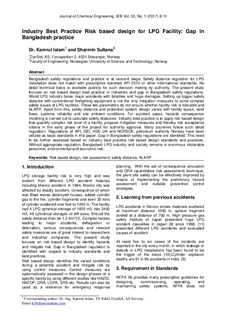| dc.contributor.author | Sultana, Sharmin | |
| dc.contributor.author | Islam, Kamrul | |
| dc.date.accessioned | 2018-12-17T10:00:48Z | |
| dc.date.available | 2018-12-17T10:00:48Z | |
| dc.date.created | 2018-12-14T20:12:20Z | |
| dc.date.issued | 2017 | |
| dc.identifier.citation | Journal of Chemical Engineering. 2017, 30 (1), 8-11. | nb_NO |
| dc.identifier.issn | 2221-7436 | |
| dc.identifier.uri | http://hdl.handle.net/11250/2577888 | |
| dc.description.abstract | Bangladesh safety regulations and practice is at nascent stage. Safety distance regulation for LPG installation does not match with prescriptive standard API 2510 or other international standards. No detail technical basis is available publicly for such decision making by authority. The present study focuses on risk based design best practice in industries and gap in Bangladesh safety regulations. World LPG industry faces major accidents with fatalities and huge damages. Setting up bigger safety distance with conventional firefighting equipment is not the only mitigation measures to solve complex safety issues of LPG facilities. These two parameters do not ensure whether facility risk is tolerable and ALARP. Apart from this, safety distance and protection system design varies with facility layout, wind flows, systems reliability and site ambient conditions. For accident cases, hazards consequence modeling is carried out to calculate safety distances. Industry best practice is to apply risk based design that quantify complex risk level of a facility, propose mitigation measures and thereby risk acceptance criteria in the early phase of the project for authority approval. Many countries follow such detail regulation. Regulations of API, ISO, HSE UK and NORSOK, petroleum authority Norway have been utilized as basic standards in this paper. Gap in Bangladesh safety regulations are identified. This need to be further assessed based on industry best practice risk based design standards and practices. Without appropriate regulation, Bangladesh LPG industry and society remains in enormous intolerable personnel, environmental and economic risk. | nb_NO |
| dc.language.iso | eng | nb_NO |
| dc.publisher | Bangladesh Academy of Sciences | nb_NO |
| dc.title | Industry Best Practice Risk based design for LPG Facility: Gap in Bangladesh practice | nb_NO |
| dc.type | Journal article | nb_NO |
| dc.type | Peer reviewed | nb_NO |
| dc.description.version | publishedVersion | nb_NO |
| dc.source.pagenumber | 8-11 | nb_NO |
| dc.source.volume | 30 | nb_NO |
| dc.source.journal | Journal of Chemical Engineering | nb_NO |
| dc.source.issue | 1 | nb_NO |
| dc.identifier.doi | https://doi.org/10.3329/jce.v30i1.34790 | |
| dc.identifier.cristin | 1643594 | |
| dc.description.localcode | © The Authors. Open Access. | nb_NO |
| cristin.unitcode | 194,64,20,0 | |
| cristin.unitname | Institutt for marin teknikk | |
| cristin.ispublished | true | |
| cristin.fulltext | original | |
